Raising Water Consciousness through
World’s Biggest Photo Exhibition and
Largest collection of Photo Stories on Water
Photo Stories | Drinking Water
Children and Water: An Insight from Gender Perspective
Nandita Singh and Om Prakash Singh
29 October, 2016
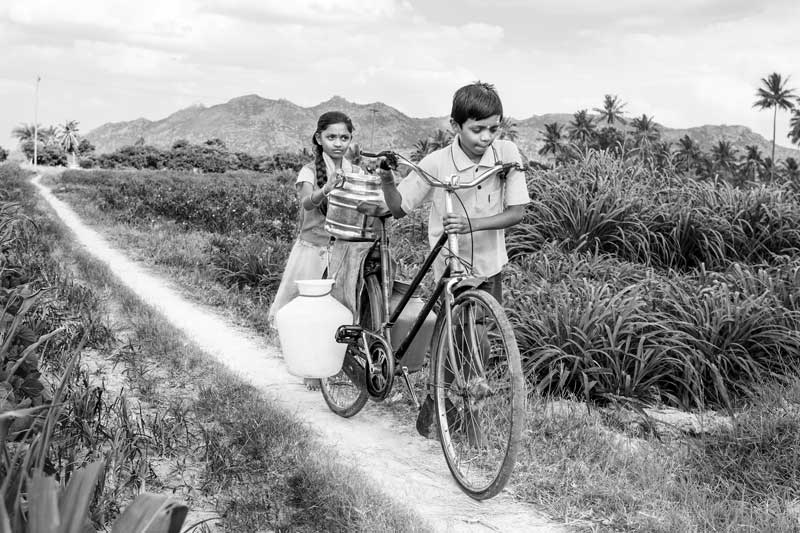
India has among the largest child populations in the world. According to the Census of 2011, 29.5% of the country’s population is less than 15 years of age. While water is essential for the life and development of these children, about 53% households in the country lack access to a safe water source at home. This directly puts health and wellbeing of the children residing in these households at risk because their access to sufficient and safe water for drinking, hygiene and other personal uses is affected. However, a more pertinent risk for children in these households arises from their participation in domestic water management. Children are found to assist their families in procuring water from outside sources, be it queuing up at a public water point, physical collection of water or transportation of the collected water back home. It is often believed that girls, more often in rural settings, are involved. However, this photo story unravels that children’s involvement in domestic water management in India occurs in rural as well as urban settings and children of both genders are generally engaged. However, the task distribution may vary between the genders, depending upon the specificities of the situation. Both boys and girls may carry water containers on the head or take the assistance of bicycle. Boys may also make use of other modes of transport such as animal carts. Also, boys more often engage in transporting bigger water containers compared to girls. Another noteworthy aspect is the range of the age at which children start shouldering these responsibilities. Boys and girls as young as four or five years of age may be engaged in the task, and as they grow older, the load and extent of responsibility may increase. While children’s assistance at home with water procurement facilitates their own and family’s access to water, it may have several serious negative implications for their own health, education, wellbeing and overall development, ultimately thwarting the enjoyment of many of their human rights as children and later on as adults. This photo story presents glimpses of the concerns facing children in India – boys and girls – who live in households lacking a water source and assist their families in procuring domestic water. The title photo portrays siblings fetching sweet and safe water back home from a distant irrigation tubewell in Kolar district, Karnataka. The drinking water source of their village is saline and fluoride-affected, forcing them to carry heavy water loads across undulating fields and on makeshift paths on field boundaries.
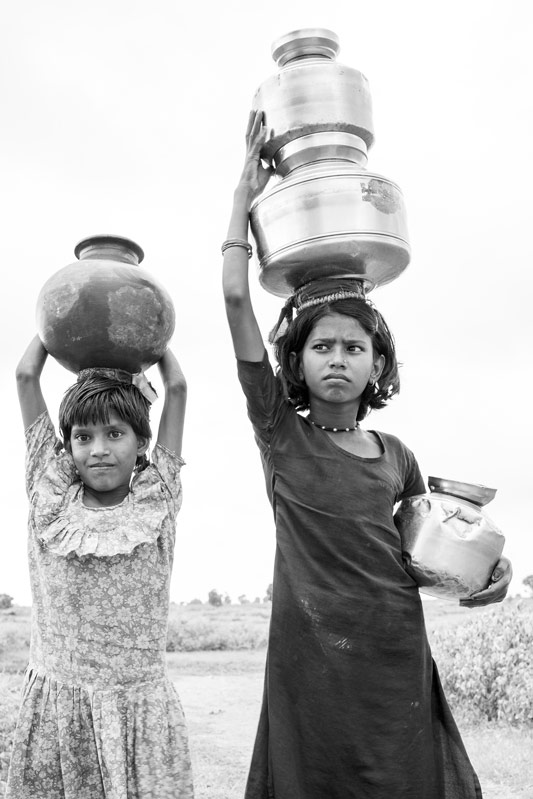
Girls carrying multiple water pots from a distant handpump in a village in Shivpuri district, Madhya Pradesh
In the northern part of Madhya Pradesh, particularly in the districts of Shivpuri, Gwalior, Morena and Bhind, individual household-based water sources in rural areas are few. Many families depend upon communal sources such as handpumps or wells. In many cases, even these tend to dry up during the summers since the water table is quite low. As a result, girls and sometimes even boys are sent out to fetch water. They travel to distant sources during the day, carrying multiple loads to last for the day for everyone at home. Sometimes, they may also need to undertake multiple trips during the day, irrespective of season, braving through the heat of summer day or rains or even the cold winter breeze. Carrying heavy loads of water once or more times a day poses risks of neck and spinal injury, which on being continued over prolonged periods could imply appearance of physical problems at an early age.
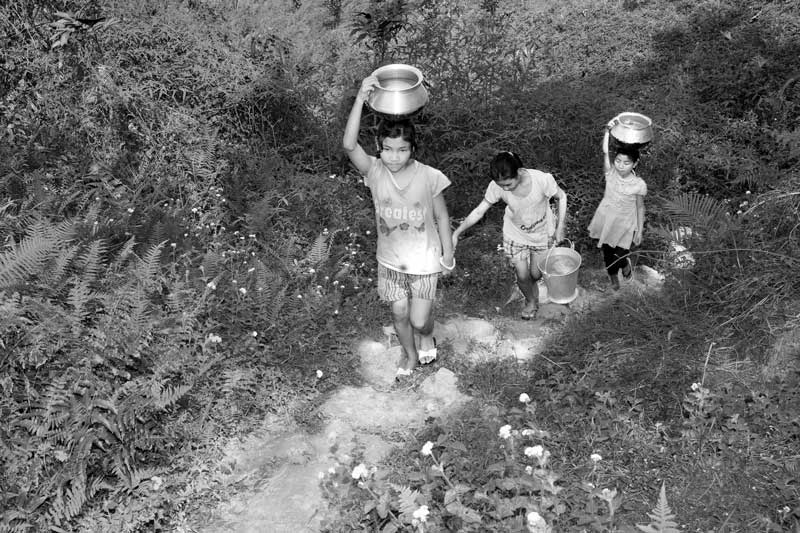
Girls carrying water up the hill from a protected spring in Tirap open cast coal mine area in Tinsukhia district, Assam
As a result of long term open cast mining in the area, the green cover is denuded and the topography disturbed, disrupting the natural springs originally providing water in the village settlements for larger part of the year. As a result, the local population has to procure water from protected springs at the hill base, but these are distant, inconvenient and provide intermittent water supply especially during summer. Young girls often help with procuring water from these springs, but it implies many risks for them. They have to walk through deep forests where they are exposed to the threat of wild animals. The paths meandering through the hills are undulating, steep and often slippery. Carrying water containers on the head or in the hands along these meandering paths poses serious risks since even slight loss of balance can become a question of life and death.
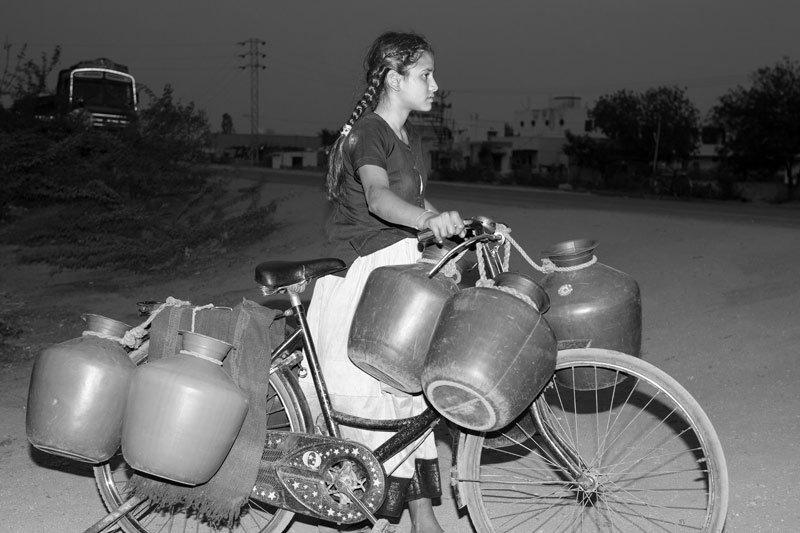
An adolescent girl returning home with partially filled containers at dusk in Anantpur town, Andhra Pradesh
Girls and boys may be equally engaged in the task of water procurement from a distance. Where the distance is long and the water load required to be carried is large, even girls may transport water on the bicycle. This girl has to cross a highway in order to reach the public standpoint that supplies drinking water for a short while only once in the day, during the evening. The problems faced by children in such a venture are significant, since there is always a risk of losing balance with a heavy load on the cycle, resulting in serious injury. Moreover, speeding trucks frequently ply on the highway which is crossed to get the water, which can any time end up as fatal. Even after all the effort and risk, sometimes she may have to return without any water or with only few pots filled, as on this day since by the time of her turn at the tap, the water supply had almost ended.
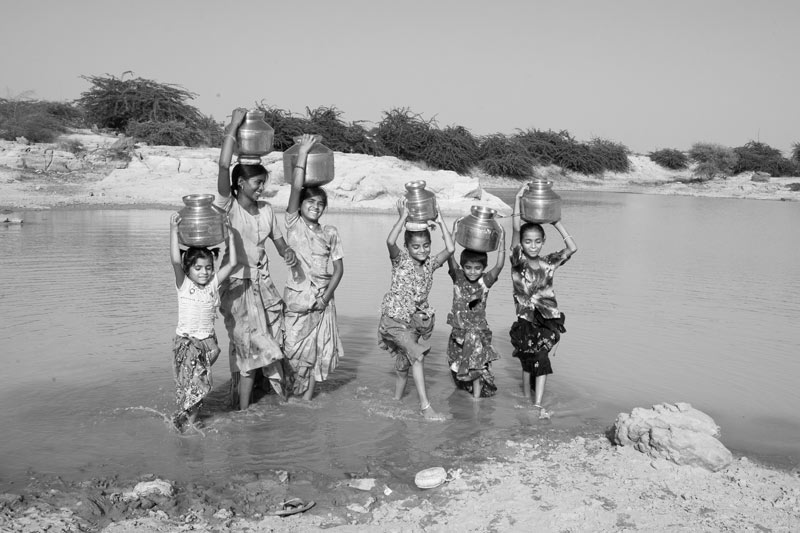
Fetching drinking water from an open pond in Kutch district, Gujarat
Groundwater in the district of Kutch is affected by salinity and fluoride contamination, forcing rural communities to search for alternate sources of potable water. Ponds are a useful alternative since these primarily contain recharged rainwater. However, not every village possesses a pond and sometimes long distances have to be traversed in order to procure potable water. Considering time limitations, girls may be sent out to bring drinking water from the ponds, whether far or near. However the, risk of microbial contamination is high in pond water, since water is collected directly by entering the water body. Also these ponds are often open and equally used by animals. This exposes the girls and their families to health risks.
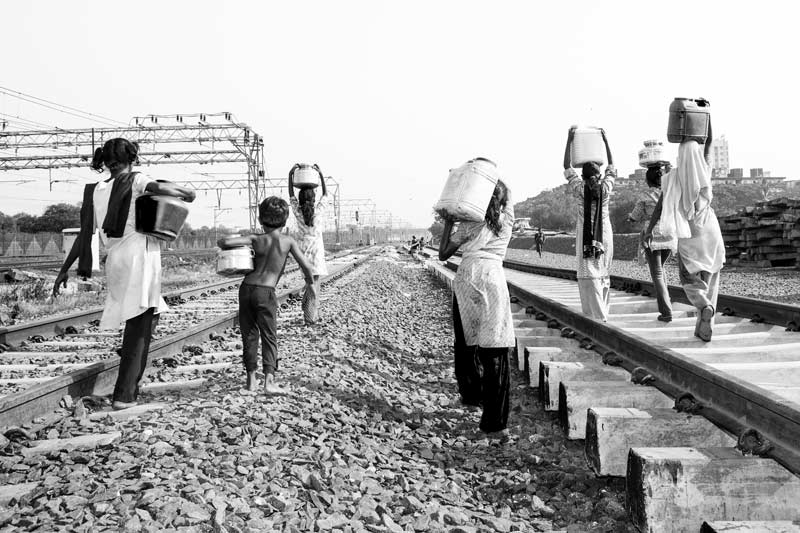
Risking lives for water in Mumbai, Maharashtra
Many slums in Mumbai do not possess water sources and the residents have to procure water from outside sources that may be distant and unreliable. For residents of the slum to which these children belong the only source is leakage from a pipeline located about 5 kilometers away that supplies water to a neighboring colony. The leakage from this pipeline takes the shape of a stream from which water needs to be collected slowly. Since filling water from this source is time-taking, children are often sent out for the task. However, the loads to carry are heavy and the distance is long. Hence, in order to reduce the distance by just a kilometer or two, these children take a short-cut walking along railway tracks, putting their own lives in great danger. These railway tracks are on the Mumbai mainline where trains ply frequently and if caught unaware children may end up meeting with accidents.
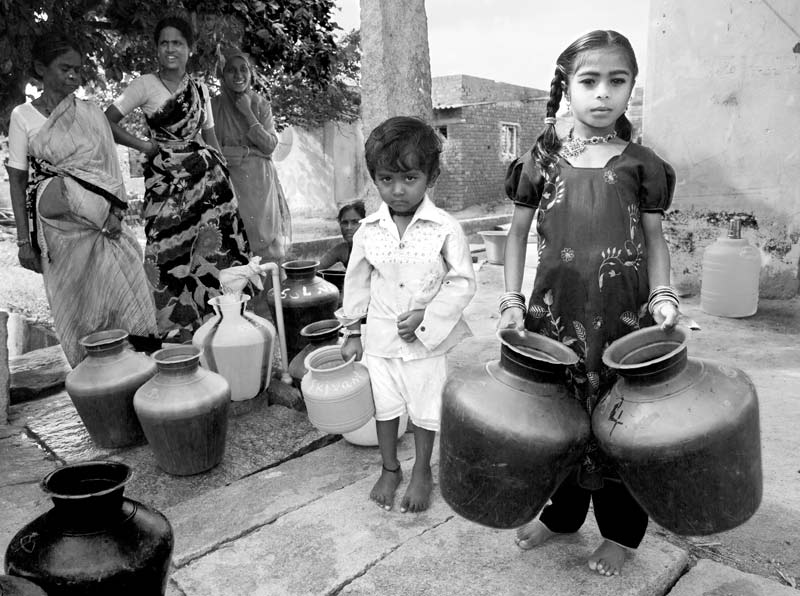
Small children waiting to fill their pots with water at a deep tubewell in a village in Kolar district, Karnataka
This deep tubewell is the only water source in the village which runs for a limited period in the day. Water procurement here is thus based on a 'first come first serve' principle. As a result, even small children aged four or five years are seen carrying water containers almost their own size. Such children may either help in reserving a place in the queue for grown-ups or fill the containers and wait for elders to carry home later. Sometimes, they may be given smaller containers that they can fill and carry home on their own. Such an engagement deprives children of the regular play time which is essential for healthy growth of their minds and bodies.
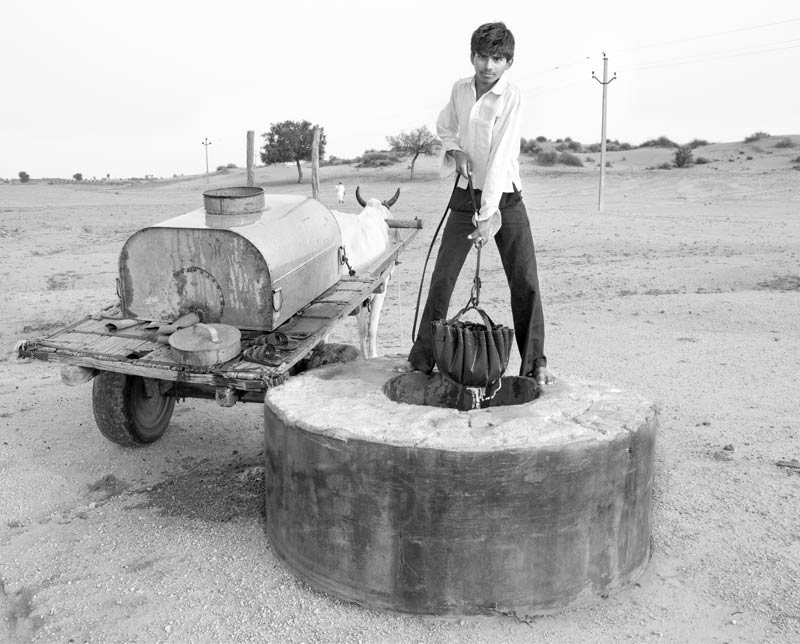
A teenager helping his family by collecting drinking water from a shallow well located outside the village in Bikaner district, Rajasthan
In the western part of Rajasthan, drinking water wells are often located outside the village at a spot where the local topography directs the rainwater flow to recharge the shallow aquifers. In the absence of any other reliable source nearby, drinking water needs to be collected from these rather shallow wells on a regular basis round the year. Often children shoulder the responsibility of collecting as well as transporting bulk water reserves over the long distance through camel cart, bullock cart and bicycle. The water tank on this bullock cart holds about 700-800 liters water which is enough for this boy's family for 4-5 days. However, manually filling this large tank is tedious and exhaustive, and at the end, one becomes completely drained out so that even maintaining focus on studies or even recreation becomes difficult.
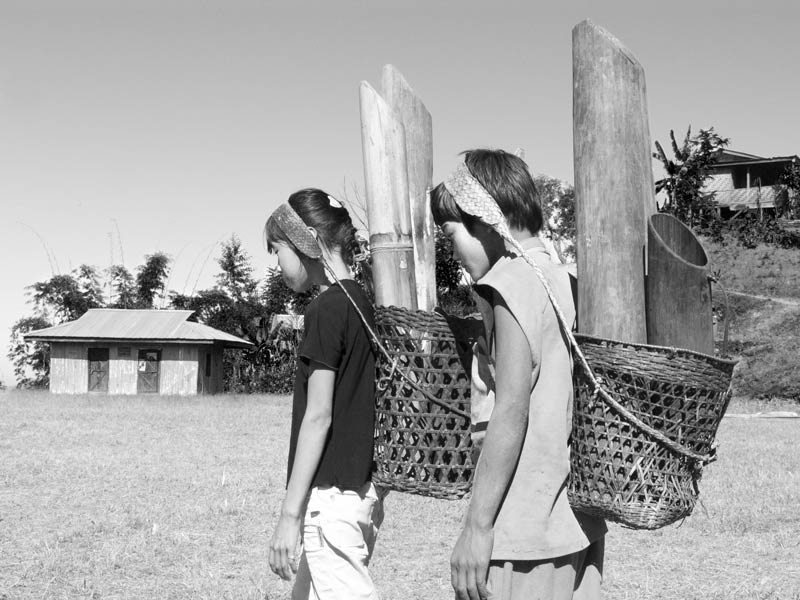
Naga children going to fetch water from a protected spring down the hill in Tuensang district, Nagaland
In Nagaland, villages are mostly perched on the hill top which makes access to water a significant problem. When the village streams and springs start drying up after the monsoon season, more distant water sources down the slopes need to be explored. These sources may often be located off the regular village pathways, and could be approached only with great difficulty. Fetching water by children from these sources during the dark hours early in the morning or late in the evening is full of physical risks for them.
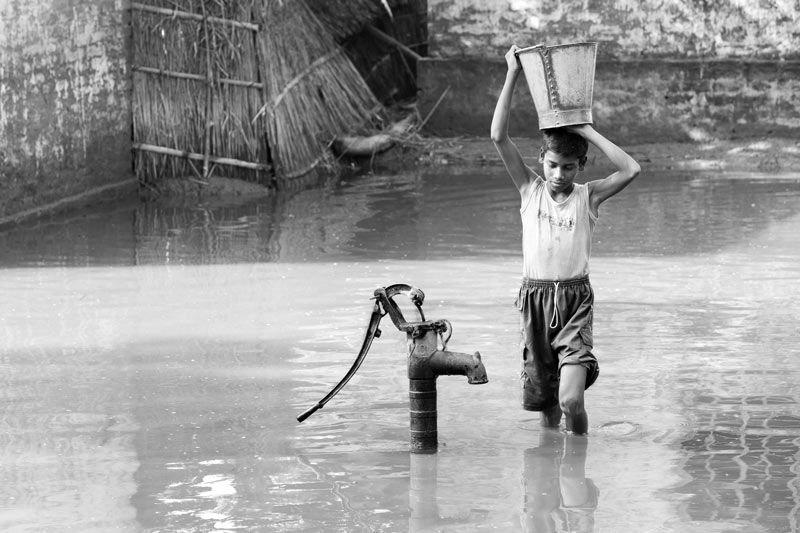
A boy carrying a bucket of 'safe' water amidst floods in West Champaran district, Bihar
During floods, access to safe water becomes a challenge for everyone. Flood restricts movements and can cause submergence of drinking water sources, making flood-affected populations search for accessible safe sources. Children may help in shouldering this responsibility but they may face several risks. Wading through flood waters may bring the risk of slipping or getting stuck in the mud underneath or even getting bitten by snakes or other organisms inside the water. Above all, though the drinking water may be fetched very carefully, as is being done by the boy in this case, the water produced by the handpump is actually unsafe due to submergence under flood water which gets polluted from multifarious sources. Consumption of this water may further pose health risk to children and other family members.
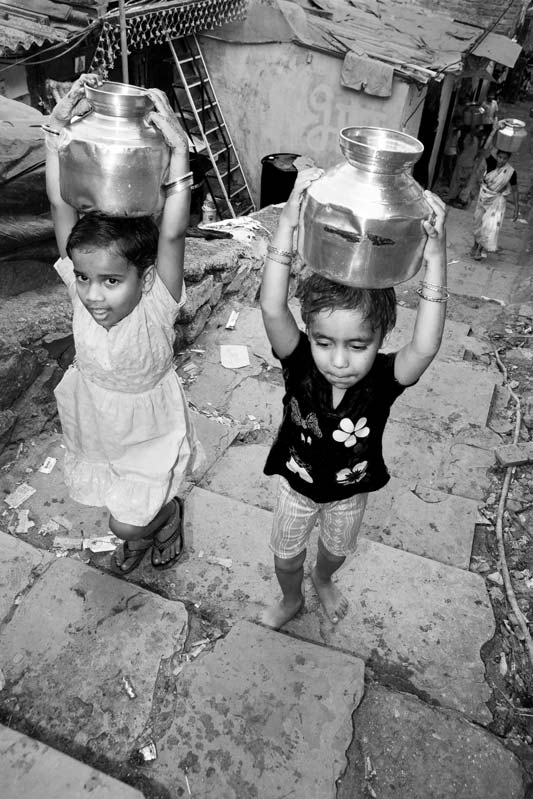
Very small children carrying loads of water uphill in Mumbai, Maharashtra
In this unsettled colony in Mumbai, most households procure water from group connections that are located down the hill. The water supply is limited in time with many contenders, which makes water fetching a family affair. Even very small children – boys as well as girls as old as five or six – are sent out with containers to get as much water as they can. These two young children are carrying about 5-10 liters of water each. Consistently carrying heavy weights at such a tender age can cause injury and stunted growth, and ultimately affect proper physical growth and development. Moreover, shouldering this responsibility at such a tender age snatches away the opportunity to enjoy their childhood.
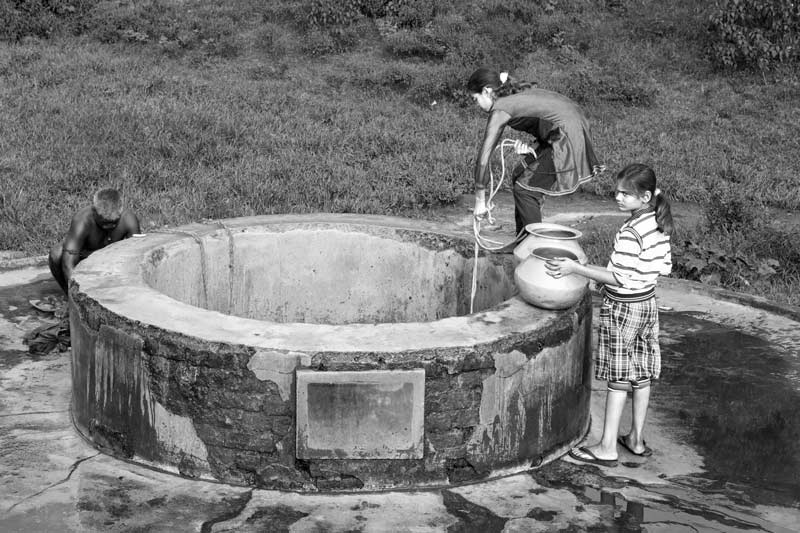
Children fetching water from a deep well in a village in Jharia coal fields, Dhanbad district, Jharkhand
In many rural settlements, open communal wells are the water source. While wells may provide water round the year, fetching water from an open well can pose substantial risks for children. Where pulley is not available, children need to haul up water with a bucket and rope. If the water is very deep and the child is small, this may require considerable energy input, making it a tiring act. Additionally, if the lining around the well is too high and the water is deep, the child may need to climb over it in order to draw the water up. A slight loss of balance in this critical position may make the entire exercise life-threatening.
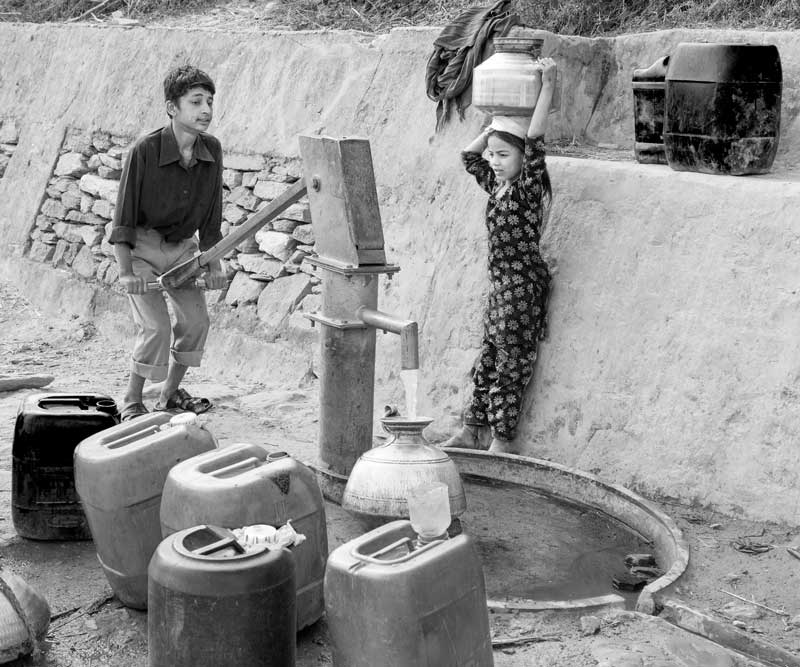
Procuring water from a roadside handpump in Tehri district, Uttarakhand
In the hilly state of Uttarakhand, drinking water supply round the year within village settlements is becoming a distant dream, with the traditional sources based primarily on mountain streams and springs beginning to dry up as soon after monsoon. The agencies have responded to the crisis by providing deep handpumps, but since the villages are generally located on hilly slopes, drilling of handpumps has been possible only along the roads. The water table in these handpumps becomes very low particularly in the summers, necessitating very hard pumping. In these circumstances, filling up several pots, jerricans and drums by children drains away much of their energy, making them physically weak.
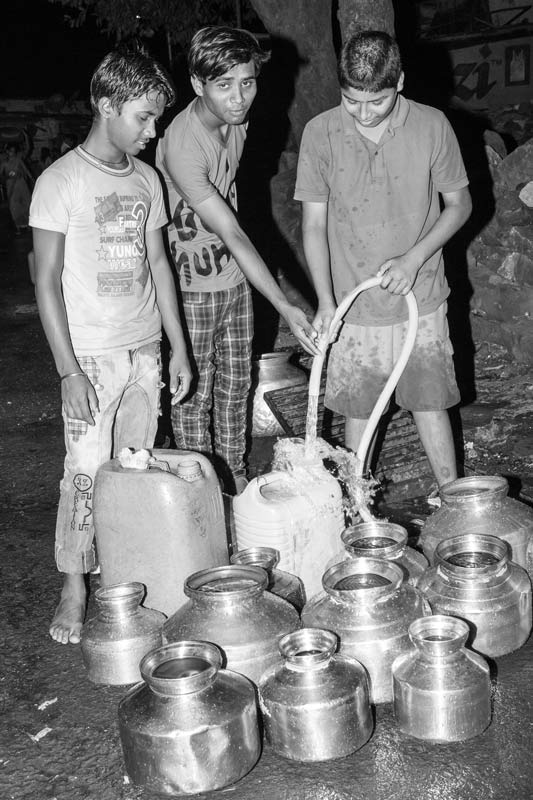
Prioritizing water over sleep in Mumbai, Maharashtra
At around 11 o'clock in the night, boys are collecting water from a group connection. The time of water supply at this point is uncertain, making them wait for hours, and waste their valuable time which could have been rightfully used either for studies or sleep. In addition, since the population dependent on this source is large, they have to battle through the challenges of queue, rush and sometimes conflicts. Ultimately, heavy loads of water need to be transported back home in the dead of the night. The implications for proper sleep, rest and education of these adolescents are imminent and sleeping late in the night makes it problematic for waking up on time for school the next morning.
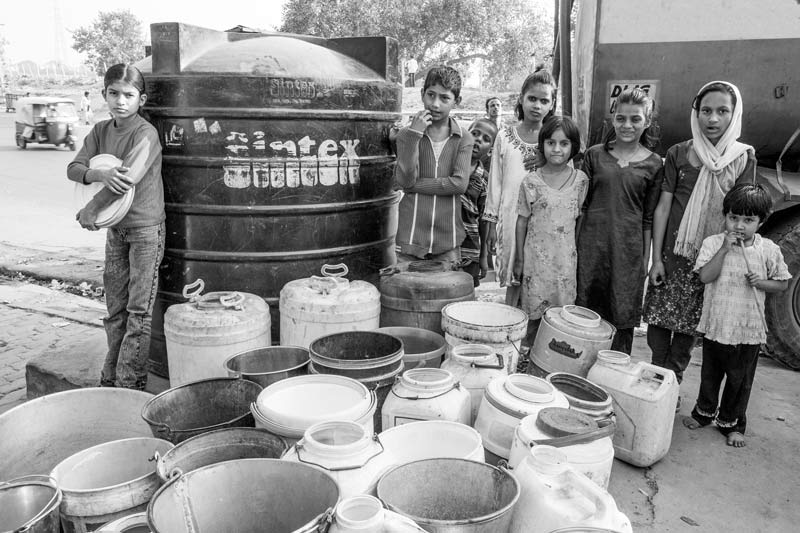
Waiting endlessly for the water tanker in North-East district, National Capital Territory of Delhi
In many informal colonies in Delhi, water is supplied through tankers, but their timing is uncertain and sometimes inconvenient. Boys and girls of all ages can be seen waiting for arrival of the tanker, together with multiple containers big and small. Children often lose their valuable time for studies or play, and may even have to miss school. Sometimes they have to miss school in this venture, and other times lose valuable play or study time. However, at the end, it may also happen that the tanker does not turn up at all. In this case, the tanker arrived more than one hour after the scheduled time.
Considering the centrality of water in children’s lives, it is essential that their access to safe and sufficient water be ensured. In fact, water has been specifically recognized as their basic right and seen as a prerequisite for realization of a number of their other rights. The General Comment No. 15, 2002 recognizes children as a special group and obliges governments to ensure that they are not prevented from enjoying their human rights owing to lack of adequate water in households or through burden of collecting water. Their right to water is also protected by the UN Convention on Rights of the Child (CRC, 1989) and considering the question as holding special significance for girls, the right has been provided additional protection under the Convention on Eradication of All forms of Discrimination Against Women (CEDAW, 1979). However, as this photo story exemplifies, human right to water remains a distant dream for many children in both rural and urban India. Not only is access to safe and sufficient water denied, but their hardships in procuring water for themselves and their families are several, which in turn impinges upon the enjoyment of many of their other human rights. The high number of diarrheal deaths and increasing incidences of fluorosis among children are indicators of health implications while high rate of school dropouts among boys and girls living in rural and informal urban settlements reflects the educational implications. Due to the burden of shouldering the responsibility of water at a tender age, children in such households are not able to live and enjoy healthy childhoods, finally affecting their lives as adults as well. If the children’s access to safe and sufficient water is to be secured, in turn facilitating the enjoyment of many of their other human rights, notably the rights to health, education, culture and development, there is need to identify the real barriers and address them appropriately and adequately.